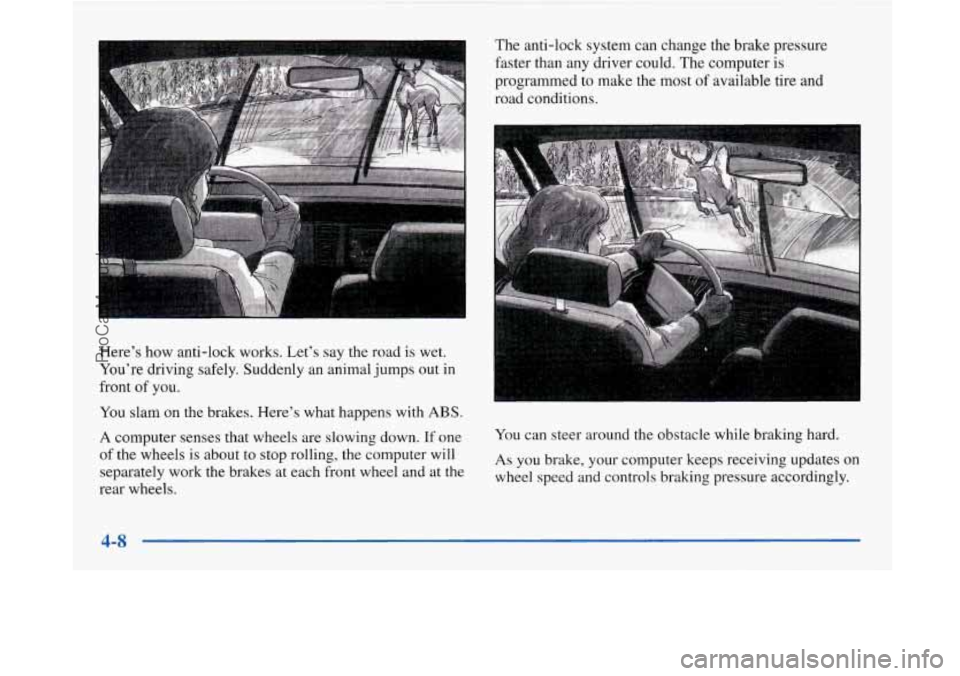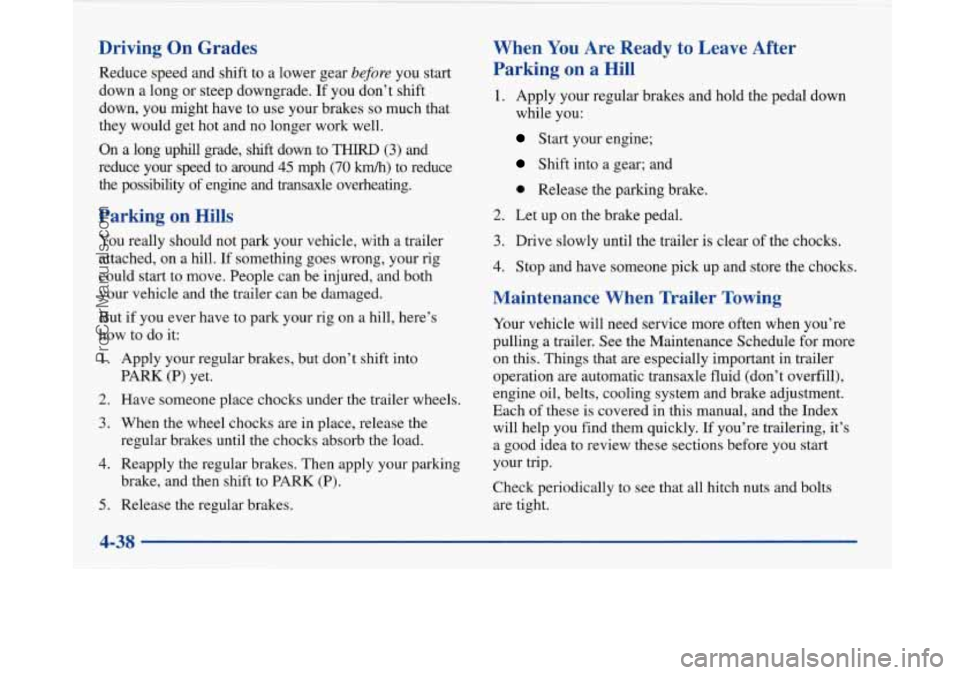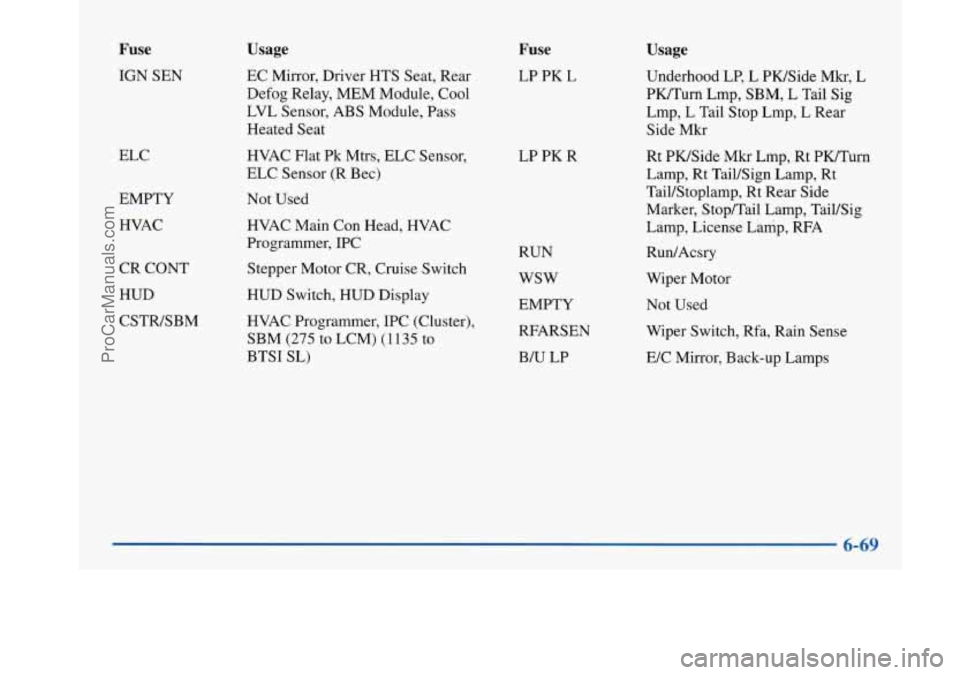1997 BUICK PARK AVENUE ABS
[x] Cancel search: ABSPage 195 of 420

Avoid needless heavy bralung. Some people drive in Anti-Lock Brakes
spurts -- heavy acceleration followed by heavy
braking
-- rather than keeping pace with traffic. This is a
mistake. Your brakes may not have time to cool between
hard stops. Your brakes will wear out much faster if you Your
vehicle has anti-lock brakes (ABS). ABS is an
advanced electronic braking system that will help
prevent a braking skid.
do a lot of heavy braking. If you keep pace with the
traffic and allow realistic following distances, you will
eliminate a lot
of unnecessary braking. That means
better braking and longer brake life.
If your engine ever stops while you’re driving, brake
normally but don’t pump your brakes.
If you do, the
pedal may get harder to push down. If your engine
stops, you will still have some power brake assist. But
you will use it when you brake. Once the power assist is
used up, it may take longer to stop and the brake pedal
will be harder to push. When
you start your engine, or when you begin to drive
away, your anti-lock brake system will check itself. You
may hear a momentary motor or clicking noise while
this test is going on, and you may even notice that your
brake pedal moves a little. This is normal.
If there’s a problem with the
anti-lock brake system, this
warning light will stay on. See “Anti-Lock Brake
System Warning Light”
in the Index.
4-7
ProCarManuals.com
Page 196 of 420

Here’s how anti-lock works. Let’s say the road is wet.
You’re driving safely. Suddenly an animal jumps out in
front of you.
You slam on the brakes. Here’s what happens with
ABS.
A computer senses that wheels are slowing down. If one
of the wheels is about to stop rolling, the computer will
separately work the brakes at each front wheel and at the
rear wheels. The
anti-lock system can change the brake pressure
faster than any driver could. The computer is
programmed to make the most
of available tire and
road conditions.
You can steer around the obstacle while braking hard.
As you brake, your computer keeps receiving updates on
wheel speed and controls braking pressure accordingly.
4-8
ProCarManuals.com
Page 203 of 420

Loss of Control
Let’s review what driving experts say about what
happens when the three control systems (brakes, steering
and acceleration) don’t have enough friction where the
tires meet the road to do what the driver has asked.
In any emergency, don’t give up. Keep trying to steer and
constantly seek an escape route or area of less danger.
Skidding
In a skid, a driver can lose control of the vehicle.
Defensive drivers avoid most skids by taking reasonable care suited to existing conditions, and by not
“overdriving” those conditions. But skids are
always possible.
The three types of sluds correspond to your Buick’s
three control systems. In the braking skid, your wheels
aren’t rolling. In
the steering or cornering skid, too
much speed or steering in a curve causes tires to slip and
lose cornering force. And in the acceleration skid, too
much throttle causes the driving wheels to spin.
A cornering skid is best handled by easing your foot off
the accelerator pedal.
If you have the traction control system, remember: It
helps avoid only the acceleration skid. If you
do not have traction control, or if the system is
off, then an acceleration skid is also best handled by
easing your foot off the accelerator pedal.
If your vehicle starts to slide, ease your foot off the
accelerator pedal and quickly steer the way you want the
vehicle to go. If you start steering quickly enough, your
vehicle may straighten out. Always be ready for a
second skid if it occurs.
Of course, traction is reduced when water, snow, ice,
gravel or other material is on the road. For safety, you’ll
want to slow down and adjust your driving to these
conditions. It is important to slow down
on slippery
surfaces because stopping distance will be longer and
vehicle control more limited.
While driving on a surface with reduced traction, try
your best to avoid sudden steering, acceleration or
braking (including engine braking by shifting to a lower
gear). Any sudden changes could cause the tires to slide.
You may not realize the surface is slippery until your
vehicle is skidding. Learn to recognize warning
clues
-- such as enough water, ice or packed snow on
the road to make a “mirrored surface”
-- and slow
down when you have any doubt.
Remember: Any anti-lock brake system
(ABS) helps
avoid only the braking
shd.
4-15
ProCarManuals.com
Page 226 of 420

Driving On Grades
Reduce speed and shift to a lower gear before you start
down a long or steep downgrade.
If you don’t shift
down, you might have to use your brakes
so much that
they would get hot and no longer work well.
On a long uphill grade, shift down to
THIRD (3) and
reduce your speed to around
45 mph (70 km/h) to reduce
the possibility of engine and transaxle overheating.
Parking on Hills
You really should not park your vehicle, with a trailer
attached, on a hill. If something goes wrong, your rig
could start to move. People can be injured, and both
your vehicle and the trailer can be damaged.
But if you ever have to park your rig on a hill, here’s
how to do it:
1. Apply your regular brakes, but don’t shift into
2. Have someone place chocks under the trailer wheels.
3. When the wheel chocks are in place, release the
regular brakes until the chocks absorb the load.
4. Reapply the regular brakes. Then apply your parking
brake, and then shift to PARK (P).
5. Release the regular brakes.
PARK (P) yet.
When You Are Ready to Leave After
Parking
on a Hill
1. Apply your regular brakes and hold the pedal down
while you:
Start your engine;
Shift into a gear; and
0 Release the parking brake.
2. Let up on the brake pedal.
3. Drive slowly until the trailer is clear of the chocks.
4. Stop and have someone pick up and store the chocks.
Maintenance When Trailer Towing
Your vehicle will need service more often when you’re
pulling a trailer. See the Maintenance Schedule for more
on this. Things that
are especially important in trailer
operation are automatic transaxle fluid (don’t overfill),
engine oil, belts, cooling system and brake adjustment.
Each of these is covered in this manual, and the Index
will help you find them quickly. If you’re trailering, it’\
s
a good idea to review these sections before you start
your trip.
Check periodically to see that all hitch nuts and bolts
are tight.
ProCarManuals.com
Page 329 of 420

Appearance Care Materials Chart
PART NUMBER SIZE DESCRIPTION USAGE
994954 23 in. x 25 in. Polishing Cloth - Wax Treated
Exterior Polish
1050004 2.75
sq. ft. Chamois Shines vehicle without scratching
1050 172 16
oz. (0.473 L)
Tar and Road Oil Remover Also removes old waxes and polishes
1050173 16
02. (0.473 L) Chrome Cleaner and Polish
Removes rust and corrosion
1050 174 16
oz. (0.473 L) White Sidewall Tire Cleaner
Removes soil and black marks
1050200 1 gal. (3.785
L) Magic Mirror Cleaner Polish
'Exterior cleaner and polish
-
1050214 32 oz. (0.946 L) Vinyl Cleaner
Spot and stain removal
1050427 23
oz. (0.680 L) Glass Cleaner Cleans grease, grime and smoke film
1052870 16
02. (0.473 L) Wash and Wax Concentrate
Exterior wash
1052918"" 8
oz. (0.237 L) Armor All Rvl Protector Protects vinyl, leather and rubber
1052925 16
02. (0.473 L) Multi-Purpose Powdered Cleaner
Cleans vinyl, cloth, tires and mats
1052929 16
oz. (0.473 L) Wheel Cleaner
Spray on wheel cleaner
I 1052930 I 8 oz. (0.237 L) I Capture Dry Spot Remover I Attracts and absorbs soils
12345002"" 16
02. (0.473 L) Armor All Cleaner Cleans vinyl, leather and rubber
12345725 12
oz. (0.354 L) Silicone Tire Shine Shines tires
12377964 16
oz. (0.473 L) Cleaning Wax Protects finish and removes fine scratches
12377966
I 16 oz. (0.473 L) I I Spot cleans paint and gives high luster
Finish Enhancer
See your General Motors
Parts Department for these products. **Not recommended for use on instrument panel vinyl.
See "Fluids and Lubricants" in the Index.
6-65
ProCarManuals.com
Page 333 of 420

Fuse
IGN SEN
Usage
EC Mirror, Driver HTS Seat, Rear
Defog Relay, MEM Module, Cool
LVL Sensor, ABS Module, Pass
Heated Seat
Fuse
LP PK L
Usage
Underhood LP, L PWSide Mkr, L
PWTurn Lmp, SBM, L Tail Sig
Lmp, L Tail Stop Lmp, L Rear
Side Mkr
ELC
EMPTY
HVAC
CR CONT
HUD
CSTWSBM HVAC
Flat Pk Mtrs, ELC Sensor,
ELC Sensor (R Bec)
Not Used
HVAC Main Con Head, HVAC
Programmer, IPC
Stepper Motor CR, Cruise Switch
HUD Switch, HUD Display
HVAC Programmer, IPC (Cluster),
SBM
(275 to LCM) (1 135 to
BTSI SL) LP
PK R
RUN
wsw
EMPTY
RFARSEN B/U LP Rt
PWSide Mkr Lmp, Rt PWTurn
Lamp, Rt TaiUSign Lamp, Rt
TaiUStoplamp, Rt Rear Side
Marker, Stop/Tail Lamp, Tail/Sig
Lamp, License Lamp, RFA
Run/Acsry
Wiper Motor Not Used
Wiper Switch, Rfa, Rain
Sense
E/C Mirror, Back-up Lamps
ProCarManuals.com